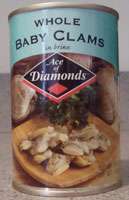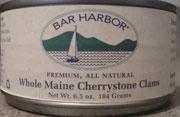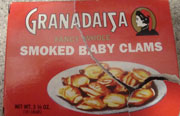Clams Ahoy!
Everything you always wanted to know about Clams but were afraid to ask!!
Canned Clams
Clams - The All Purpose Bivalve
Fresh clams are best. That said, there are occasions when canned clams are handy to have around. They can back up a limited supply of clams you’ve just dug in a dish like clam pie, or they can be tasty in the winter when clamming is cold and nasty. Canned clams are also used in commercial manufacturing and, unfortunately, are sometimes used in restaurants to make chowder even when fresh meat is available. Canned clams are cheaper than fresh ones.
There are various types of canned clams available, including chopped, whole, smoked, and more. My local grocery store contained more varieties than expected, especially since fresh ones are commonplace and relatively inexpensive here in New England.
Canning itself began with American industrialization.
Clarence Birdseye’s freezing process allowed the transportation of food
crops over long distances, bringing vegetables to areas with short or no
growing
 season.
Canning, the hermetic sealing of foodstuffs for preservation, can be a home
practice but for the most part involves mass production. Like many canned
foods, clams have sodium added to them before they are sealed in airtight
metal containers. This improves flavor and retards spoilage. World War II
was a major impetus to industrial canning. Troops needed field rations that
were safe to eat. The food production business made famous on San
Francisco’s Cannery Row began with small fish like sardines and anchovies,
as well as clams, shrimp and oysters (sometimes smoked – another technique
to retard spoilage and add savory flavor). Because clams are high in trace
metals and are 100% protein, canned clams can be a useful contribution to
the diet when fresh food is unavailable.
season.
Canning, the hermetic sealing of foodstuffs for preservation, can be a home
practice but for the most part involves mass production. Like many canned
foods, clams have sodium added to them before they are sealed in airtight
metal containers. This improves flavor and retards spoilage. World War II
was a major impetus to industrial canning. Troops needed field rations that
were safe to eat. The food production business made famous on San
Francisco’s Cannery Row began with small fish like sardines and anchovies,
as well as clams, shrimp and oysters (sometimes smoked – another technique
to retard spoilage and add savory flavor). Because clams are high in trace
metals and are 100% protein, canned clams can be a useful contribution to
the diet when fresh food is unavailable.
In recent years, a trend toward healthier eating has drawn
attention to high sodium levels in canned food. Major manufacturers such as
Campbell’s are introducing low sodium brands, although none of these is a
dominant market player, for the simple reason food with more salt usually
tastes better. Canned clams make up a small portion of the canned foods
market, and to date s odium
content and possible health risks associated with the smoking process, such
as polycyclic aromatic hydrocarbons (PAHs), have not been an obstruction to
purchase. PAHs are compounds created by burning that make smoked or grilled
food taste better, but are thought to be associated with an increased risk
of certain cancers.
odium
content and possible health risks associated with the smoking process, such
as polycyclic aromatic hydrocarbons (PAHs), have not been an obstruction to
purchase. PAHs are compounds created by burning that make smoked or grilled
food taste better, but are thought to be associated with an increased risk
of certain cancers.
Canned meats generally have not been preferred in the US
outside fixed uses such as for travel and for the military. Still, everyone
knows tuna fish, a source of tasty protein for decades.
Aquacultured clams
are most often canned (or frozen). Most US grocery retailers carry several varieties of canned clams at any given time.
Well-known national canned clam brands include Ace of Diamonds Whole Baby
Clams in Brine; Bar Harbor Whole Maine Cherrystone Clams; Snows Chopped
Clams (owned by Bumble Bee) and
Granadaija Smoked Baby Clams
retailers carry several varieties of canned clams at any given time.
Well-known national canned clam brands include Ace of Diamonds Whole Baby
Clams in Brine; Bar Harbor Whole Maine Cherrystone Clams; Snows Chopped
Clams (owned by Bumble Bee) and
Granadaija Smoked Baby Clams
 Hi,
we are Ted and John, just two guys who love Clams and other seafood.
Hi,
we are Ted and John, just two guys who love Clams and other seafood.